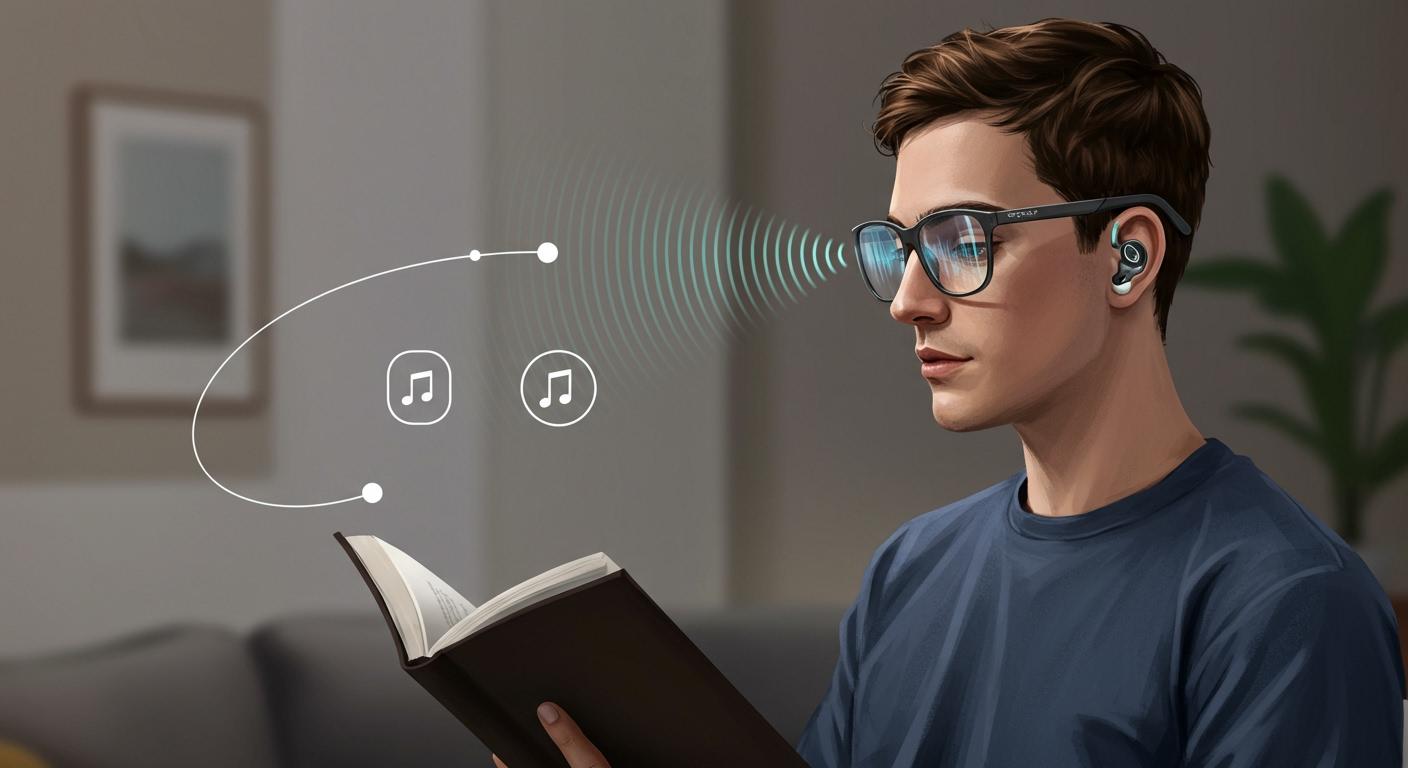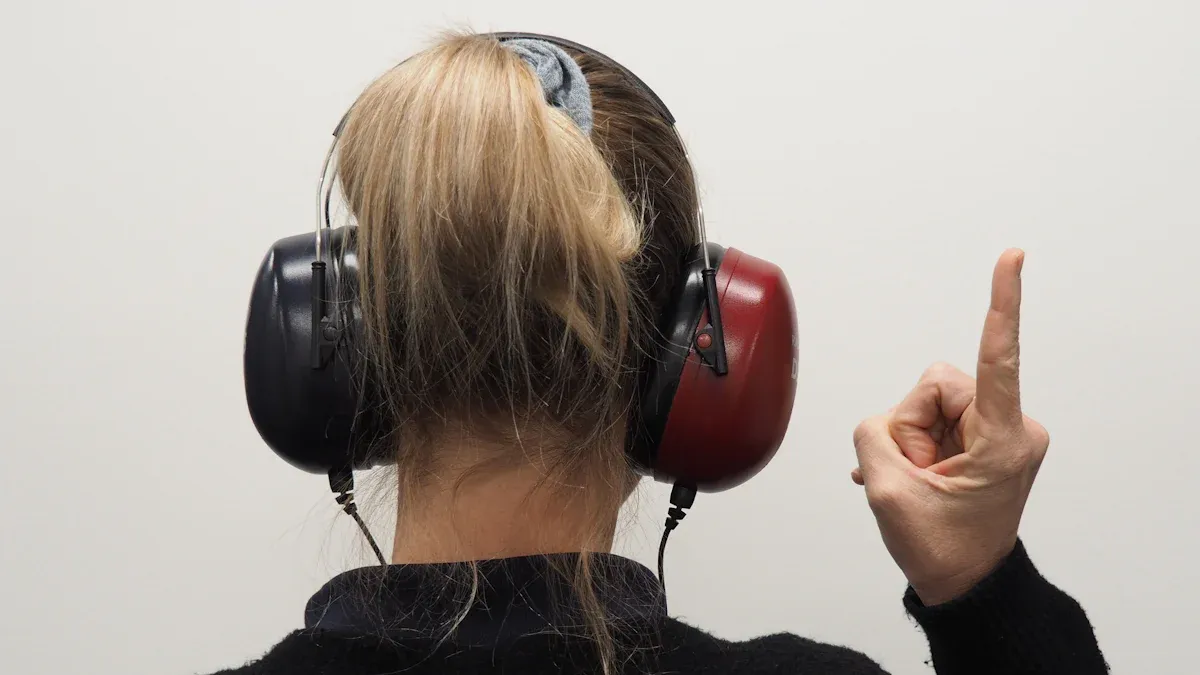
How Do Audio Glasses Enhance Hearing
Share

You hear more clearly with audio glasses because they use smart technology. Acoustic beamforming points sound at your ears, so you can hear speech better. Open-ear speakers let you listen and still notice things around you. Noise-cancelling microphones lower background sounds, so voices are easier to hear. Many types give you great sound and feel good to wear. You can pick from many styles, even ones for prescription lenses. Simple controls and long battery life make these glasses easy to use every day.
Key Takeaways
Audio glasses use smart tools to help you hear better. They make speech easier to hear and lower other noises.
Open-ear speakers let you listen to music and still hear what is around you. You can notice traffic and alarms.
Microphone arrays make voices sound clearer by blocking out noise. This helps you follow talks in loud places.
You can change audio settings with an app. You can turn the volume up or down and pick different modes for how you want to listen.
Audio glasses can have prescription lenses added. They help you see clearly and hear better every day.
Audio Glasses Technology
Acoustic Beamforming
Acoustic beamforming helps you hear speech more clearly. It sends sound straight to your ears. You hear the speaker from the front. Sounds from the sides and back get quieter.
Speech is easier to understand in noisy places.
The microphones pick up the main speaker’s voice. They block out other sounds.
You can hear important talks, even when it is loud.
Studies show beamforming sensors help with voice interaction. These sensors are sensitive and do not pick up much noise. Some smart glasses use "acoustic touch." This turns objects into special sounds. It helps people who need extra help hearing or knowing what is around them.
Open-Ear Speakers
Open-ear speakers let you hear music and voices. You can still notice things around you. Your ears are not blocked. You can hear traffic, alarms, and people talking.
Here is a table that explains open-ear speaker technology:
Feature |
Description |
|---|---|
Technology |
Bose OpenAudio™ lets you hear music and your surroundings. |
Acoustic Package |
Thin acoustic parts in the temples make real-sounding audio. |
Sound Spread |
The design keeps sound close to you and stops it from spreading. |
Directional speakers send sound toward your ears. The design keeps your audio private and clear. You can listen to podcasts or calls. You do not miss what is happening nearby. Open-ear audio lets you connect to smart devices. You can use voice assistants or play music and stay alert.
Microphone Array
Microphone arrays help separate speech from noise.
You hear better because microphones focus on the speaker.
Neural networks tell speech and noise apart. You hear voices more clearly.
Both ears help the system know what you hear. Speech stands out.
Beamformers make speech louder and cut down noise.
You notice voices are easier to understand. Some hearing glasses make voices up to 4.4 decibels clearer. You can change audio settings with an app. You control volume, switch programs, and mute noise. These features make your experience personal and easy.
Tip: Use the app to control your audio glasses. Change the volume, pick sound modes, and find your device easily.
Hearing Enhancement Features

Speech Clarity
You want to hear every word when you talk. Audio glasses help you do this. They use special microphones and smart technology. These make voices easier to hear. If you are in a busy place, the glasses focus on the speaker. You hear their words clearly, even with other people talking.
Let’s look at how audio glasses and hearing aids help with speech clarity:
Feature |
Nuance Audio Glasses |
Traditional Hearing Aids |
|---|---|---|
Design |
Looks like regular glasses, not easy to see |
Often more visible, design varies |
Comfort |
Open-ear style, does not bother your ears |
In-ear types can feel uncomfortable |
Speech Clarity |
Good with beamforming microphones |
Can be changed for severe hearing loss |
Hearing Loss Suitability |
Works for mild or moderate hearing loss |
Works for all levels of hearing loss |
Battery Life |
Lasts 8-10 hours per charge |
Some models last over 20 hours |
Customization |
Not much fine-tuning |
Lots of ways to adjust settings |
About $1,200 |
$3,000–$6,000 for each pair |
|
Bluetooth Streaming |
Not available |
Many models have it |
Overall Performance |
Good for everyday use, not for severe loss |
Best for people who need strong help |
Audio glasses work best for mild or moderate hearing needs. They help you have clear talks every day. You do not have to worry about big or uncomfortable devices.
Noise Reduction
Loud places can make talking hard. Audio glasses use noise reduction to help you listen better. They use special algorithms to block unwanted sounds. Here is a table that shows how these features work:
Description |
|
|---|---|
Active Noise Cancellation (ANC) |
Microphones find and stop background noise, so voices are clearer. |
Wind Noise Management |
Cuts down wind sounds, so it is easier to listen outside. |
Directional Microphones |
Focuses on your voice and the person you talk to, making other noises quieter. |
You can walk outside on a windy day and still hear your friend. You can sit in a busy café and have a private chat. These features help you stay connected and enjoy every moment.
Tip: If you want to hear only the person in front, use the directional microphone mode. This blocks most background noise.
Adjustable Audio Modes
Everyone hears things in their own way. Audio glasses let you change the sound to fit you. You can turn the volume up or down. You can pick a mode that works best for you. Some glasses have special audio profiles and EQ settings. These let you choose how music, voices, or outdoor sounds come through.
You can switch between modes for music, talking, or outdoor use.
You can turn up the volume if you need to hear better.
You can lower the volume to stay aware of what is around you.
These choices make your listening personal. You get to pick what sounds you want to hear more. You can have clear talks at a party or listen to music while walking outside.
Everyday Comfort and Integration
Prescription Lens Compatibility
Audio glasses look like normal glasses. You can use them with many lens types. There are choices for regular and prescription lenses. Some models help with special vision problems. These include strabismus correction and fixing refractive errors. If you need glasses for reading or computer work, you can pick lenses that help your eyes feel less tired.
Lens Type |
Description |
|---|---|
Non-prescription lenses |
Gray and Emerald choices you can buy. |
Prescription lenses |
Many options for different vision needs. |
Strabismus correction |
Helps you see depth by fixing eye alignment. |
Refractive errors |
Helps with blurry vision, like nearsightedness or astigmatism. |
Convergence insufficiency |
Makes reading easier and helps you focus up close. |
You can keep your vision needs and still hear better. Audio glasses fit into your daily life and help your eyes.
Style and Fit
You can choose a style you like. Audio glasses come in lots of shapes and colors. You can find square frames or panthos shapes. There are finishes like shiny black or burgundy. Some brands have blue light filters and special lenses for comfort.
Many shapes
Different colors
Cool finishes
Frame Shape |
Finish |
|---|---|
Square |
Shiny Black |
Panthos |
Burgundy |
Most people think regular sunglasses feel lighter all day. Audio glasses might feel heavier and warmer after a while. Your ears may get tired if you wear them too long. For short times, audio glasses are comfy and look good.
Tip: Try different shapes and finishes to see what fits you best.
Ease of Use
You can control audio glasses with easy taps or an app. You can answer calls, use voice commands, or change the volume. Some models let you start translation or switch sound modes with a long press. The speakers are hidden and the microphones work well for everyone.
Feature |
Description |
|---|---|
Hidden design for mild or moderate hearing loss. |
|
Smartphone App Connectivity |
Simple controls for volume and noise. |
Directional Sound Amplification |
Makes sound louder from certain directions. |
Volume Control Options |
Change settings on the glasses, with a remote, or an app. |
You do not need to know a lot about tech to use these. The controls are simple so anyone can hear clearly and stay in touch.
You hear sounds better and feel comfortable with audio glasses. People say they like how clear the sound is. They also say it is easier to listen and talk. The open-ear design is a favorite for many users.
Benefit |
Description |
|---|---|
Many people say the sound is very clear. |
|
Reduced listening effort |
Talking feels easy and natural with these glasses. |
Preference for open-ear design |
Most users like this more than regular hearing aids. |
Studies show people talk better and have more fun with others. Experts think audio glasses are good for mild hearing loss. You can notice things around you and use them every day. Try audio glasses or ask a hearing expert to help you choose.
FAQ
Can you use audio glasses with prescription lenses?
Yes, you can use audio glasses with prescription lenses. Many brands let you choose lens types that fit your vision needs. You get clear sight and better hearing at the same time.
Do audio glasses help in noisy places?
Audio glasses use microphones and smart noise reduction. You hear voices better in busy spots like restaurants or parks. The glasses focus on speech and block out background sounds.
How do you control audio glasses?
You control audio glasses with taps, buttons, or a smartphone app. You can change the volume, switch sound modes, or answer calls. The controls are simple and easy to learn.
Are audio glasses comfortable for all-day wear?
Most audio glasses feel light and fit well. You can wear them for hours without discomfort. Some users say their ears get tired after long use, so try different styles for the best fit.
Can you listen to music and still hear your surroundings?
Yes, open-ear speakers let you enjoy music or calls. You still hear traffic, alarms, and people talking. You stay aware of your environment while using audio glasses.
